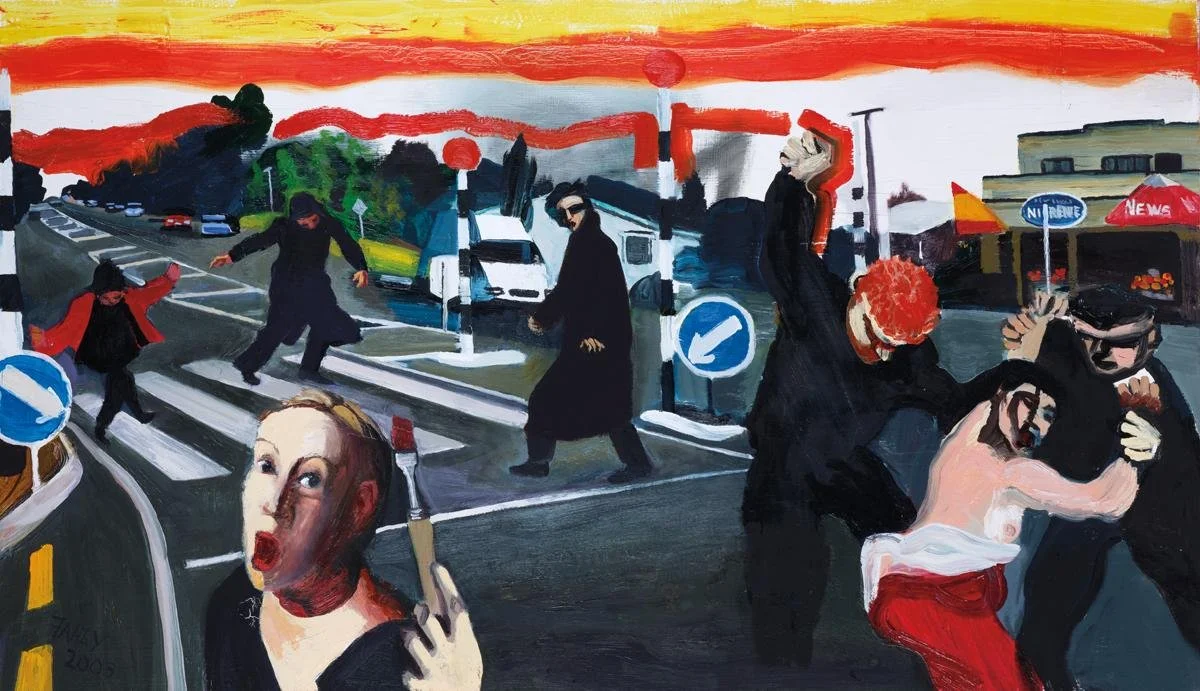Five artworks at Webb's upcoming Works of Art auction
A closer look at a selection of our highlights, with artworks by Jacqueline Fahey, Séraphine Pick, Peter Robinson, Michael Smither, and Douglas Wright.
Peter Robinson, Necessary Protection, 1996, oilstick on canvas, 450 x 600 mm
Peter Robinson, Necessary Protection
Perhaps more relevant now than ever, Peter Robinson’s (Ngāi Tahu) Necessary Protection is imbued with the artist’s signature wit, the particularly long condom tip protruding like the end of a needle.
The title references canonical Aotearoa/New Zealand painter Colin McCahon’s odes to the landscape, birds and theology—the phrase repetitively used throughout his career and often ignited retrospectively in reference to the artist. A socio-legalistic term that speaks to a base precaution, Robinson hints at a new meaning that is satirical and implicitly challenges derelictions on Te Tiriti o Waitangi.
Douglas Wright, Black Milk, 2006, acrylic on mirror, 970 x 517 mm
Douglas Wright, Black Milk
Artist, dancer, and choreographer—Douglas Wright’s practice was highly charged and connective. Scrawled onto a mirror like basement graffiti, Black Milk presents a series of infractions and amendments spelled out in text, carelessly slipping from the edge of the frame. Yet there are no mistakes. Each line builds on the next to cut through the viewer’s image, leaving a residual sludge in the world it reflects.
Séraphine Pick, Blue Hand, 2013, oil on linen, 660 x 915 mm
Séraphine Pick, Blue Hand
Drowsy and discombobulated, a marionette broken akimbo, the figure in Séraphine Pick’s Blue Hand melts into the rickety frame on which she lies. Taken from the artist’s ‘Wankered’ series, it depicts a re-painted scene of inebriation found on the internet. The scuffled brushwork and stark highlights charge the painting with beauty and pathos otherwise missing in the source photograph.
Michael Smither, Three Rocks and a Lava Flow, 2004, oil and sand on board, 1260 x 820 mm
Michael Smither, Three Rock Pools and Lava Flow
Luminescent and phosphorous, Michael Smither’s Three Rock Pools and Lava Flow is lushly unsettling. Painted at a time when the effects of intensive dairy farming and invasive freshwater algae were beginning to wound the once pristine waterways of Aotearoa, this scene in Ngāmotu/New Plymouth returns to the place of Smither’s childhood and treats the landscape as something otherworldly and surreal.
The painting took around eight years to produce, with around 50–60 layers built up through drying and rubbing the surface with oil between each coat.
Jacqueline Fahey, Can Painting Change Anything?, 2003, oil on canvas, 707 x 1220 mm
Jacqueline Fahey, Can Painting Change Anything?
Fahey’s paintings are fiery and lyrical, cartoonishly deft and nuanced. Her figures often look like they are wearing masks, with heavily painted faces or caricatured features. They face the outside, crowding together to look at the viewer in a state of wry performance.
Can Painting Change Anything? includes a self-portrait of the artist in the foreground, her red-tipped paintbrush wielded like a weapon. Behind her a violent scene plays out while others look by or revel in unison. The sky is emblazoned with accents that lower the horizon and compress the action into a state of imminence.
Webb's Works of Art auction will take place Monday 9 August, 6:30pm.





